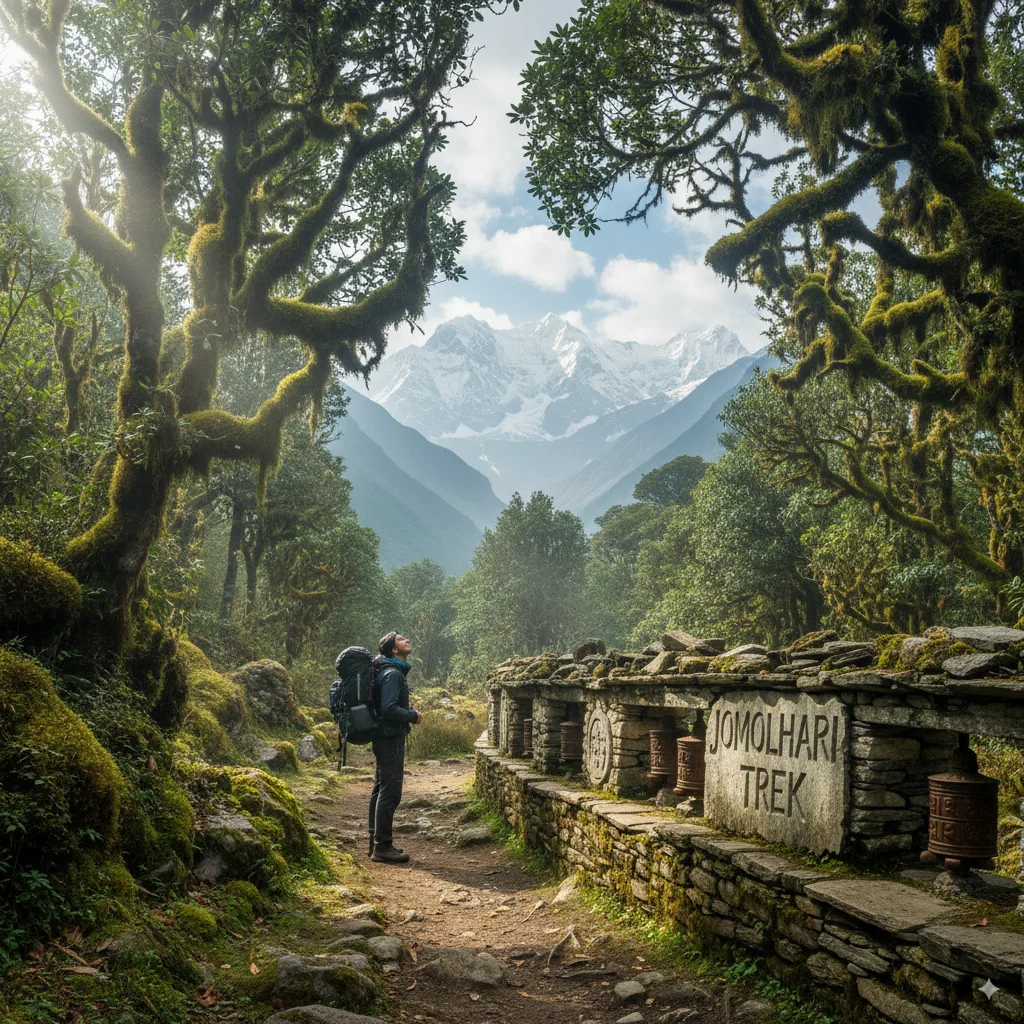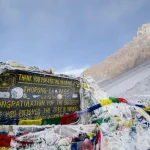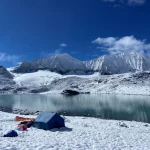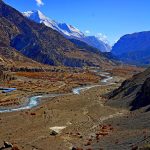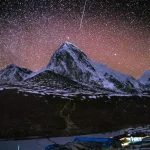The Jomolhari Trek Bhutan is one of the most iconic trekking routes in the Himalayas, offering breathtaking landscapes, ancient culture, and unparalleled views of Mount Jomolhari, the “Bride of Kangchenjunga”. For adventurers seeking an authentic and rewarding Bhutan trekking experience, this high-altitude journey blends natural beauty with Bhutan’s unique spiritual traditions. With pristine valleys, yak herders’ camps, monasteries, and dramatic mountain scenery, the trek represents the very best of Himalayan trekking routes.
We’ll go into great detail in this post about the Jomolhari Trek in Bhutan, including its history, schedule, scenery, cultural landmarks, ideal seasons, and important advice. If you’re planning your next big adventure, let’s explore why this trek is considered a bucket-list journey and how you can make it happen with expert guidance from Nepal Adventure Trail.
Why Choose the Jomolhari Trek Bhutan?
Unlike shorter hikes such as the Druk Path Trek, the Jomolhari Trek Bhutan is a longer and more challenging journey that takes you deep into Bhutan’s unspoiled wilderness. The route showcases alpine meadows, glacial rivers, and panoramic views of sacred peaks like Mount Jomolhari (7,326 m) and Jichu Drake.
This trek is ideal for those who want a balance between rugged mountain adventure and rich cultural immersion. Trekkers experience Bhutan’s distinctive Buddhist heritage, visit isolated villages, and interact with hospitable locals along the way, making it much more than just a strenuous physical journey.
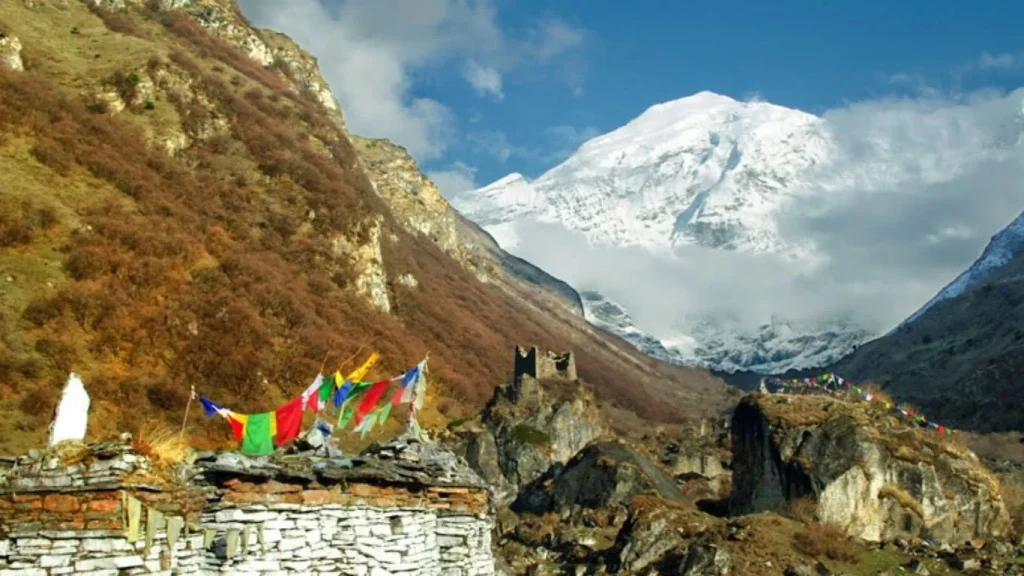
Trekking Itinerary Overview
The standard Jomolhari Trek Bhutan itinerary usually lasts 8–10 days, beginning in Paro and ending in Thimphu. Here’s a general outline of what trekkers can expect:
- Day 1–2: Paro to Sharna Zampa
The trek begins with a visit to the iconic Tigers Nest Monastery (Taktsang), one of Bhutan’s most spiritual landmarks. From Paro, hikers follow the Paro River to Sharna Zampa, gradually entering forested valleys. - Day 3–4: Thangthangkha to Jangothang Base Camp
The trail climbs past rhododendron forests and yak herders’ settlements before reaching Jangothang, the base camp at 4,080 m. This site provides jaw-dropping views of Mount Jomolhari, glowing in the evening light. - Day 5–6: High-Altitude Passes
Trekkers cross mountain passes such as Nyile La (4,890 m) and Yeli La (4,930 m), offering expansive Himalayan vistas. These are the most challenging sections of the trek, demanding proper acclimatization. - Day 7–8: Descending to Thimphu Valley
The trail winds down through alpine pastures, villages, and forests, eventually leading to Thimphu, Bhutan’s vibrant capital. This final stretch highlights the stark transition from high mountains to lush valleys.
Natural Beauty and Landscapes
One of the biggest draws of the Jomolhari Trek Bhutan is its stunning natural diversity. Trekkers pass through:
- Dense forests of blue pine, oak, and rhododendron.
- Alpine meadows dotted with wildflowers in spring and summer.
- Glacial valleys carved by ancient ice flows.
- High mountain passes offering views of peaks that straddle the Bhutan-Tibet border.
Wildlife is also abundant. The region is home to blue sheep, marmots, Himalayan monal (the national bird of Bhutan), and occasionally snow leopards. For nature enthusiasts, this trek is both a scenic and ecological treasure.
Cultural and Spiritual Highlights
What makes the Jomolhari Trek Bhutan stand out compared to other Himalayan trekking routes is its deep cultural immersion. Bhutan is the world’s last Vajrayana Buddhist kingdom, and the trail reflects this spiritual identity:
- Tigers Nest Monastery at the start of the trek offers a profound cultural initiation.
- Village encounters provide insight into traditional Bhutanese life, where farming and yak herding remain central.
- Sacred peaks like Jomolhari are worshipped as protective deities, reminding trekkers of the spiritual connection between nature and culture in Bhutan.
Every step feels like walking through a living museum of Himalayan traditions.
Difficulty Level: Is the Jomolhari Trek Bhutan for You?
The Jomolhari Trek Bhutan is considered a moderate to challenging high-altitude trek. Daily trekking hours average 6–8, with steep ascents and descents. The high passes above 4,800 m demand strong physical fitness and good acclimatization.
This trek is best suited for:
- Experienced trekkers seeking a multi-day adventure.
- Hikers comfortable with camping in remote locations.
- Travelers interested in combining cultural discovery with mountain exploration.
If you’ve completed treks like Everest Base Camp, Annapurna Circuit, or the Snowman Trek Bhutan, this route will feel like a perfect next step.
Best Time for the Jomolhari Trek Bhutan
The best time to trek in Bhutan is during the spring (March–May) and autumn (September–November).
- Spring brings wildflowers, lush meadows, and clear skies.
- Autumn offers crisp weather and the clearest mountain views.
Summer (monsoon season) can be wet and muddy, while winter makes the high passes extremely challenging due to snow.
Permits and Logistics
Trekking in Bhutan is unique because all foreign visitors must travel with a licensed tour operator. Independent trekking is not allowed. For the Jomolhari Trek Bhutan, you’ll need:
- A Bhutan visa issued through an authorized operator.
- A trekking permit for the Jomolhari route.
- Support staff including guides, cooks, and porters (organized by your operator).
This structure ensures that trekking supports local communities and minimizes environmental impact.
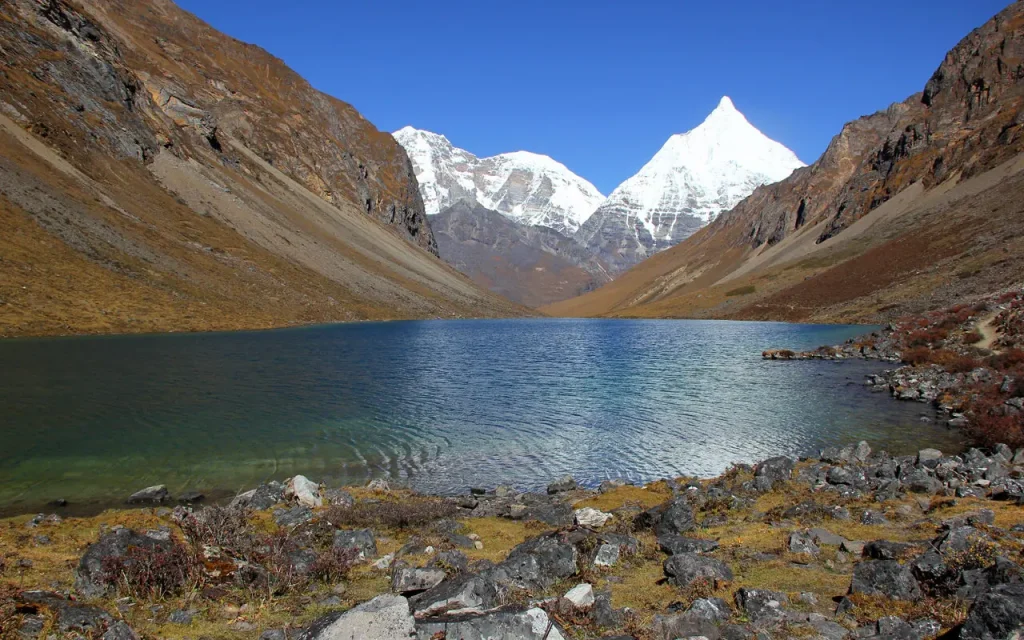
Packing and Preparation
To succeed on the Jomolhari Trek Bhutan, trekkers should prepare with:
- Proper acclimatization strategies.
- Strong fitness training, focusing on stamina and leg strength.
- Essential gear: layered clothing, sleeping bag, trekking poles, waterproof boots, and a reliable backpack.
Because Bhutan trekking involves camping rather than teahouse accommodation, packing well is key for comfort and safety.
Comparing Jomolhari Trek with Other Bhutan Treks
While the Druk Path Trek and Bumthang Cultural Trek are shorter, the Jomolhari Trek Bhutan is more remote and adventurous. It offers a unique blend of high-altitude challenge and cultural depth without being as extreme as the Snowman Trek, which is one of the toughest in the world.
If you want something longer than a week but more achievable than the Snowman, the Jomolhari strikes the perfect balance.
Why Trek Jomolhari with Nepal Adventure Trail?
When planning a trek of this scale, choosing the right operator is crucial. With years of experience in Himalayan trekking routes, Nepal Adventure Trail ensures seamless logistics, safety, and cultural immersion. From arranging permits and guides to providing acclimatization advice, they take care of every detail so you can focus on the adventure.
Whether you’re dreaming of standing beneath Mount Jomolhari, exploring hidden valleys, or experiencing Bhutanese hospitality firsthand, Nepal Adventure Trail offers expert-led packages that make your journey unforgettable.
Final Thoughts
Beyond merely hiking, the Jomolhari Trek Bhutan is an adventure into the heart of the Himalayas, where unadulterated natural beauty and ageless spirituality collide. From the legendary Tigers Nest Monastery to the rugged high passes, every moment offers a story worth remembering.
If you’re ready for an authentic Bhutan trekking adventure, this trek should be at the top of your list. With the right planning and the assistance of knowledgeable experts like Nepal Adventure Trail, the Jomolhari trek has the potential to be a physically and spiritually transformative experience.
